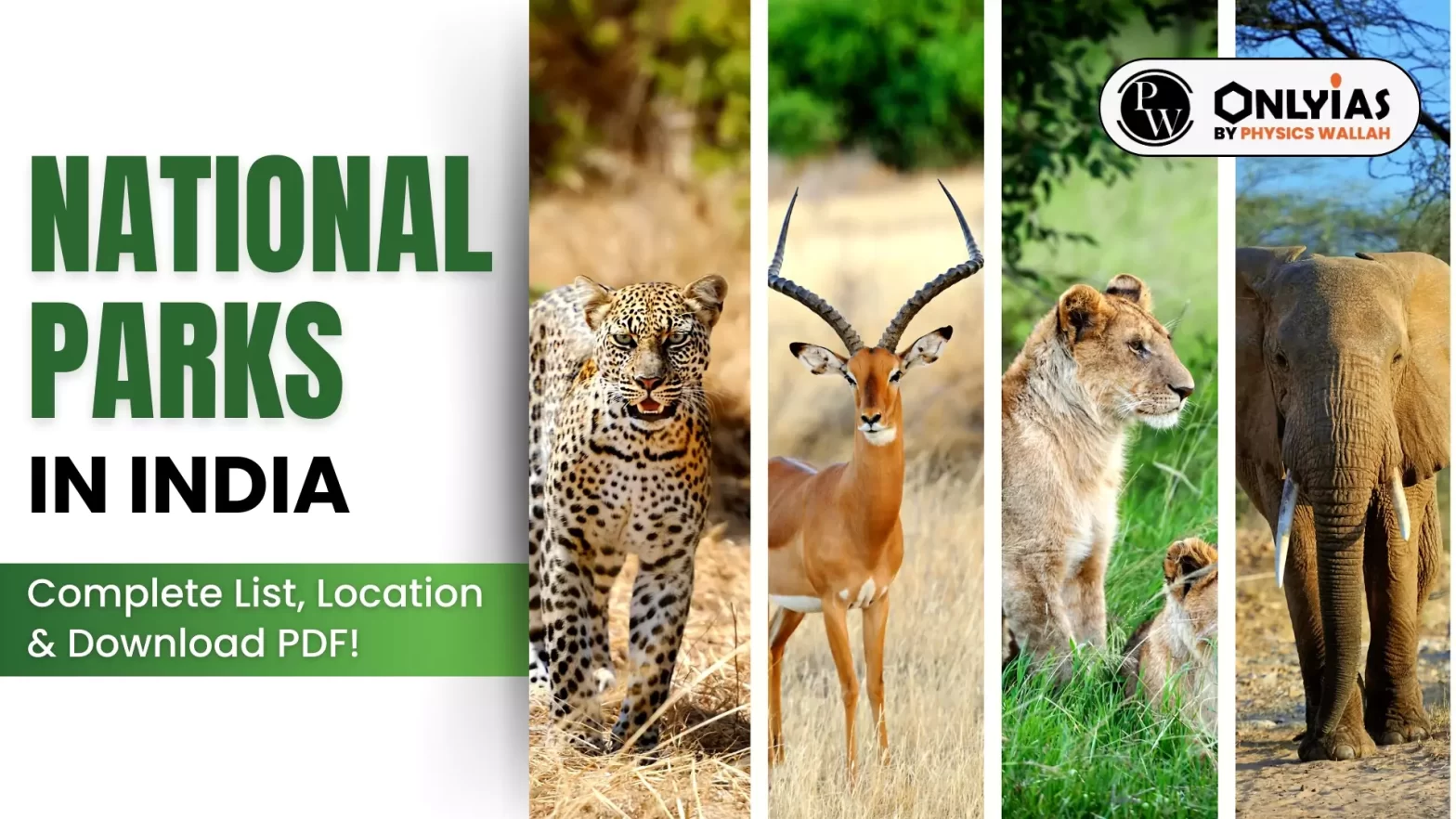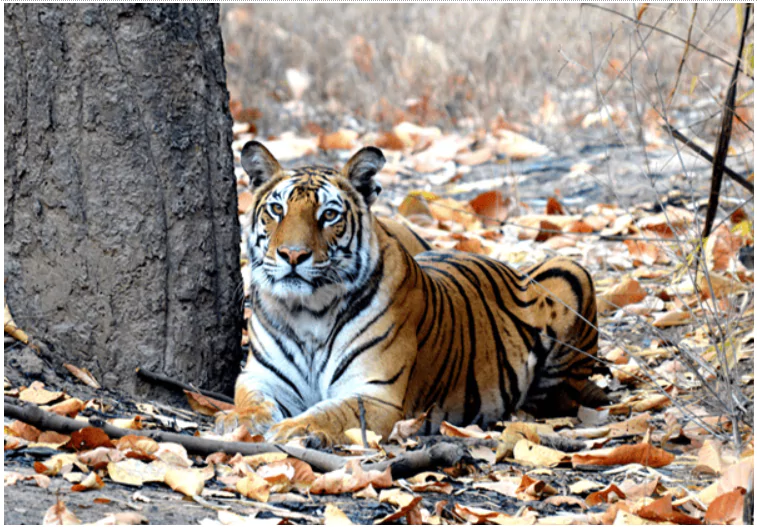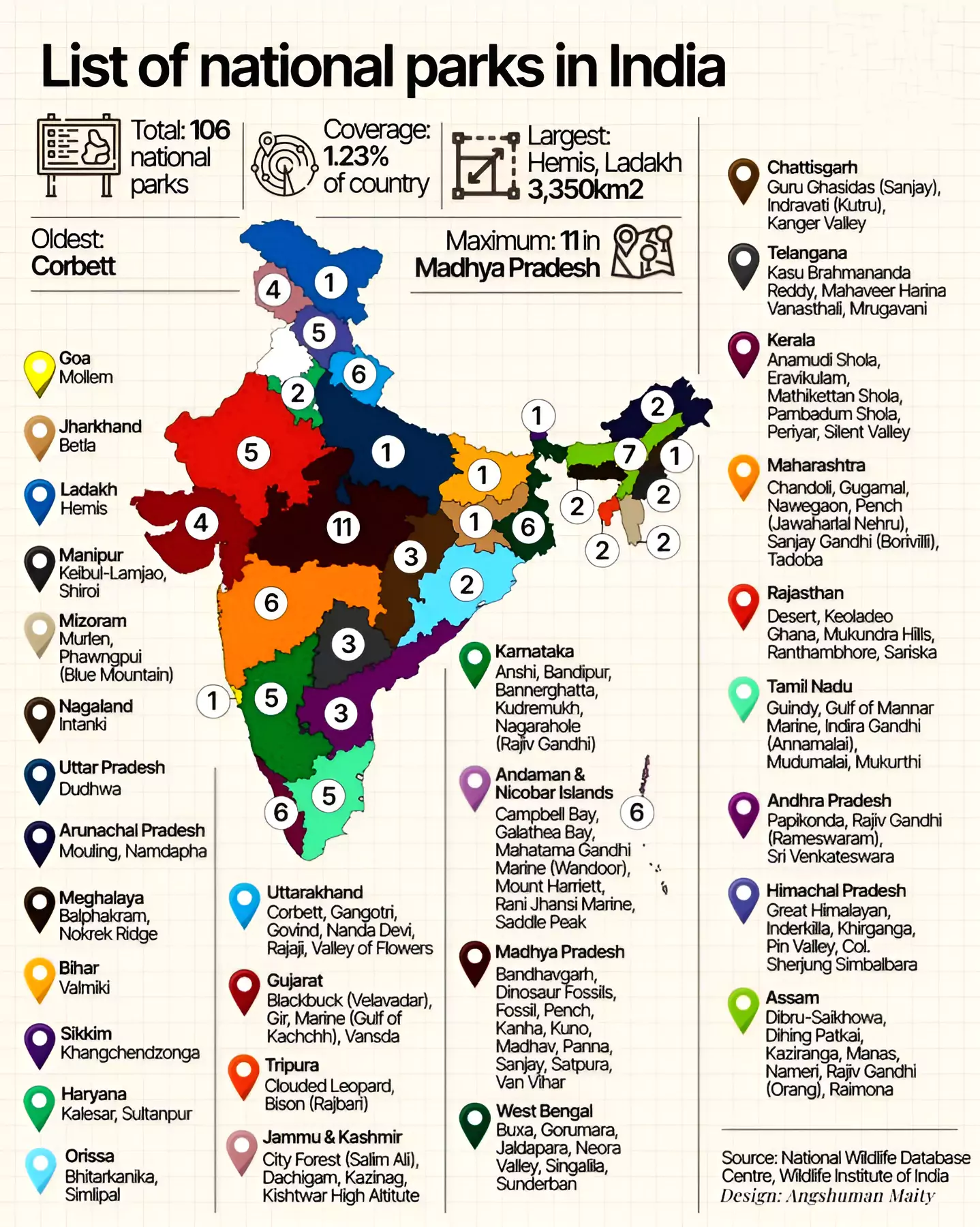
National parks are protected areas that have been established by the government (State and Central government) to conserve and protect natural resources such as forests, wildlife, flora, and fauna. National Parks are strictly protected with the aim of improving wildlife and biodiversity. National Parks play a crucial role in the conservation of wildlife, providing a sanctuary where natural habitats and prey can flourish undisturbed. Hailey National Park was established in 1936 as India’s first national park. It is now known as the Jim Corbett National Park in Uttarakhand.
Knowledge of the National Parks in India is imperative for aspirants preparing for the IAS Exam, as it forms an integral component of Indian geography and environmental studies.
National Parks in India are significant for maintaining ecological balance, safeguarding endangered species, and promoting eco-tourism. India, with its diverse flora and fauna, is home to 106 National Parks as of 2025, covering around 1.23% of the country’s geographical area. They play a critical role in preserving the natural heritage of the nation.
There are 106 existing national parks in India covering an area of 44,402.95 km2, which is 1.35% of the geographical area of the country (National Wildlife Database Centre, Nov. 2023). Below is the list of National Parks in India.
| Name of State | No. of PAs | National Parks | Year of Creation | Area
(in km2) |
| Andhra Pradesh | 1 | Papikonda | 2008 | 1012.8588 |
| 2 | Rajiv Gandhi (Rameswaram) | 2005 | 2.3952 | |
| 3 | Sri Venkateswara | 1989 | 353.62 | |
| Arunachal Pradesh | 1 | Mouling | 1986 | 483 |
| 2 | Namdapha | 1983 | 1807.82 | |
| Assam | 1 | Dibru-Saikhowa | 1999 | 340 |
| 2 | Dihing Patkai | 2021 | 234.26 | |
| 3 | Kaziranga | 1974 | 889.51 | |
| 4 | Manas | 1990 | 500 | |
| 5 | Nameri | 1998 | 200 | |
| 6 | Rajiv Gandhi (Orang) | 1999 | 78.81 | |
| 7 | Raimona | 2021 | 422 | |
| Bihar | 1 | Valmiki | 1989 | 335.65 |
| Chhattisgarh | 1 | Guru Ghasidas (Sanjay) | 1981 | 1440.71 |
| 2 | Indravati (Kutru) | 1982 | 1258.37 | |
| 3 | Kanger Valley | 1982 | 200 | |
| Goa | 1 | Mollem | 1992 | 107 |
| Gujarat | 1 | Blackbuck (Velavadar) | 1976 | 34.53 |
| 2 | Gir | 1975 | 258.71 | |
| 3 | Marine (Gulf of Kachchh) | 1982 | 162.89 | |
| 4 | Vansda | 1979 | 23.99 | |
| Haryana | 1 | Kalesar | 2003 | 46.82 |
| 2 | Sultanpur | 1989 | 1.43 | |
| Himachal Pradesh | 1 | Great Himalayan | 1984 | 754.4 |
| 2 | Inderkilla | 2010 | 94 | |
| 3 | Khirganga | 2010 | 705 | |
| 4 | Pin Valley | 1987 | 675 | |
| 5 | Col. Sherjung Simbalbara | 2010 | 27.88 | |
| Jharkhand | 1 | Betla | 1986 | 226.33 |
| Karnataka | 1 | Anshi | 1987 | 417.34 |
| 2 | Bandipur | 1974 | 872.24 | |
| 3 | Bannerghatta | 1974 | 260.51 | |
| 4 | Kudremukh | 1987 | 600.57 | |
| 5 | Nagarahole (Rajiv Gandhi) | 1988 | 643.39 | |
| Kerala | 1 | Anamudi Shola | 2003 | 7.5 |
| 2 | Eravikulam | 1978 | 97 | |
| 3 | Mathikettan Shola | 2003 | 12.82 | |
| 4 | Pambadum Shola | 2003 | 1.32 | |
| 5 | Periyar | 1982 | 350 | |
| 6 | Silent Valley | 1984 | 89.52 | |
| Madhya Pradesh | 1 | Bandhavgarh | 1968 | 448.842 |
| 2 | Dinosaur Fossils | 2011 | 0.897 | |
| 3 | Fossil | 1983 | 0.27 | |
| 4 | Pench | 1975 | 292.857 | |
| 5 | Kanha | 1955 | 941.793 | |
| 6 | Kuno | 2018 | 748.761 | |
| 7 | Madhav | 1959 | 375.23 | |
| 8 | Panna | 1981 | 542.66 | |
| 9 | Sanjay | 1981 | 464.643 | |
| 10 | Satpura | 1981 | 528.729 | |
| 11 | Van Vihar | 1979 | 4.452 | |
| Maharashtra | 1 | Chandoli | 2004 | 317.67 |
| 2 | Gugamal | 1975 | 361.28 | |
| 3 | Nawegaon | 1975 | 133.88 | |
| 4 | Pench (Jawaharlal Nehru) | 1975 | 257.26 | |
| 5 | Sanjay Gandhi (Borivilli) | 1983 | 86.96 | |
| 6 | Tadoba | 1955 | 116.55 | |
| Manipur | 1 | Keibul-Lamjao | 1977 | 40 |
| 2 | Shiroi | 1982 | 100 | |
| Meghalaya | 1 | Balphakram | 1986 | 220 |
| 2 | Nokrek Ridge | 1997 | 47.48 | |
| Mizoram | 1 | Murlen | 2003 | 100 |
| 2 | Phawngpui (Blue Mountain) | 1997 | 50 | |
| Nagaland | 1 | Intanki | 1993 | 202.02 |
| Odisha | 1 | Bhitarkanika | 1988 | 145 |
| 2 | Simlipal | 1980 | 845.7 | |
| Rajasthan | 1 | Desert | 1992 | 3162 |
| 2 | Keoladeo Ghana | 1981 | 28.73 | |
| 3 | Mukundra Hills | 2006 | 200.54 | |
| 4 | Ranthambhore | 1980 | 282 | |
| 5 | Sariska | 1992 | 273.8 | |
| Sikkim | 1 | Khangchendzonga | 1977 | 1784 |
| Tamil Nadu | 1 | Guindy | 1976 | 2.7057 |
| 2 | Gulf of Mannar Marine | 1980 | 526.02 | |
| 3 | Indira Gandhi (Annamalai) | 1989 | 117.1 | |
| 4 | Mudumalai | 1990 | 103.23 | |
| 5 | Mukurthi | 1990 | 78.46 | |
| Telangana | 1 | Kasu Brahmananda Reddy | 1994 | 1.425 |
| 2 | Mahaveer Harina Vanasthali | 1994 | 14.59 | |
| 3 | Mrugavani | 1994 | 3.6 | |
| Tripura | 1 | Clouded Leopard | 2007 | 5.08 |
| 2 | Bison (Rajbari) | 2007 | 31.63 | |
| Uttar Pradesh | 1 | Dudhwa | 1977 | 490 |
| Uttarakhand | 1 | Corbett | 1936 | 520.82 |
| 2 | Gangotri | 1989 | 2390.02 | |
| 3 | Govind | 1990 | 472.08 | |
| 4 | Nanda Devi | 1982 | 624.6 | |
| 5 | Rajaji | 1983 | 820 | |
| 6 | Valley of Flowers | 1982 | 87.5 | |
| West Bengal | 1 | Buxa | 1992 | 117.1 |
| 2 | Gorumara | 1992 | 79.45 | |
| 3 | Jaldapara | 2014 | 216.34 | |
| 4 | Neora Valley | 1986 | 159.8917 | |
| 5 | Singalila | 1986 | 78.6 | |
| 6 | Sunderban | 1984 | 1330.1 | |
| Andaman & Nicobar Islands | 1 | Campbell Bay | 1992 | 426.23 |
| 2 | Galathea Bay | 1992 | 110 | |
| 3 | Mahatama Gandhi Marine (Wandoor) | 1983 | 281.5 | |
| 4 | Mount Harriett | 1987 | 46.62 | |
| 5 | Rani Jhansi Marine | 1996 | 320.06 | |
| 6 | Saddle Peak | 1987 | 32.54 | |
| Jammu & Kashmir | 1 | City Forest (Salim Ali) | 1992 | 9.07 |
| 2 | Dachigam | 1981 | 141 | |
| 3 | Kazinag | 2000 | 90.88 | |
| 4 | Kishtwar High Altitude | 1981 | 2191.5 | |
| Ladakh | 1 | Hemis | 1981 | 3350 |
IUCN (International Union for Conservation of Nature)
Definition of National Park by IUCN
|
Importance of National Parks in India
Amidst the vibrant tapestry of India’s natural landscapes lie its National Parks, each holding a unique story of conservation and safeguarding biodiversity. With a history intertwined with the nation’s dedication to ecological preservation, these protected areas stand as sanctuaries for wildlife and havens for nature enthusiasts. Delving into the origins and roles of these National Parks unveils a journey of environmental awareness, legislative initiatives, and the pursuit of balance between human needs and the intricate ecosystems that grace the subcontinent.


Alt tag = ”map of national parks in india”
India’s National Parks are renowned for their unique wildlife, each offering a sanctuary to some of the most iconic and endangered species. From the Bengal Tigers of Ranthambore to the Indian Rhinoceroses of Kaziranga, these parks are vital for protecting the country’s diverse fauna. They also serve as popular destinations for wildlife enthusiasts and researchers, showcasing India’s incredible biodiversity.
| Animal/Bird | Predominant in Sanctuary/Reserve | State |
| Wild Ass | Rann of Kutch Wild Ass Sanctuary | Gujarat |
| One horned Rhinoceros | Kaziranga National Park | Assam |
| Elephants | Periyar National Park | Kerala |
| Asiatic Lions | Gir National Park | Gujarat |
| Great Indian Bustard | Ghatigaon Wildlife Sanctuary & Desert National Park | Madhya Pradesh & Rajasthan |
| Royal Bengal Tiger | Sundarbans National Park | West Bengal |
| Olive Ridley Turtle | Gahirmatha Turtle Sanctuary | Orissa |
| Dolphins | Vikramshila Gangetic Dolphin Sanctuary | Bhagalpur, Bihar |
| Vulture | Ramdevarabetta Vulture Sanctuary | Karnataka |
| Bear | Daroji Bear Sanctuary | Hampi, Karnataka |
| Sangai | Keibul Lamjao National Park | Loktak Lake (Bishnupur), Manipur |
| Barasingha (Swamp deer) | Kanha National Park | Madhya Pradesh |
| Siberian cranes | Keoladeo national park | Rajasthan (Bharatpur) |
| Jerdon’s Courser | Sri Lankamalleswara Wildlife Sanctuary | Andhra Pradesh |
| Gharial | National Chambal Sanctuary | U.P., Rajasthan, and M.P. |
| Grizzled Giant Squirrel | Srivilliputhur Wildlife Sanctuary | Virudhunagar & Madurai, Tamil Nadu |
| Clouded Leopard | Clouded Leopard National Park | Tripura |
| Snow Leopard | Hemis National Park | Ladakh |
| Hoolock Gibbon | Hoollongapar Gibbon Sanctuary | Assam |
| Golden langur | Chakrashila Wildlife Sanctuary & Raimona National Park | Assam |
| Hangul (Kashmir Stag) | Dachigam Sanctuary | Jammu and Kashmir |
| Nilgiri Tahr | Eravikulam National Park | Kerala |
| Red Panda | Khangchendzonga National Park | Sikkim |
While both Wildlife Sanctuaries and National Parks are protected areas aimed at conserving wildlife, National Parks have stricter regulations, prohibiting any human activity, whereas Wildlife Sanctuaries allow limited human intervention like grazing and firewood collection. National Parks focus on preserving ecosystems, while Sanctuaries are designed to protect specific species.
| Basis | Wildlife Sanctuary | National Park |
| Purpose | A wildlife sanctuary primarily aims to conserve and protect specific wildlife species. | The primary purposes of a national park are wildlife conservation, recreation, and landscape preservation. |
| Human Activities | Restricted to minimize disturbances to wildlife. | Regulated recreational activities like hiking, camping, and wildlife watching. |
| Management Focus | Its primary focus is on the conservation and protection of wildlife. | Its primary focus is on preserving ecosystems, landscapes, and cultural resources |
| Size and Boundaries | It varies in size, often smaller and localized. | It is larger, covering diverse ecosystems and landscapes. |
| Conversion | Wildlife sanctuary can be converted into a National Park. | National Park can not be converted into the wildlife sanctuary |
| Environment Notes | Environment and Ecology Notes |
| NCERT Notes | Daily Current Affairs |
| Daily Editorial Analysis | CSAT Strategy |
| UPSC Blogs | Prelims 2024 Strategy |

<div class="new-fform">
</div>